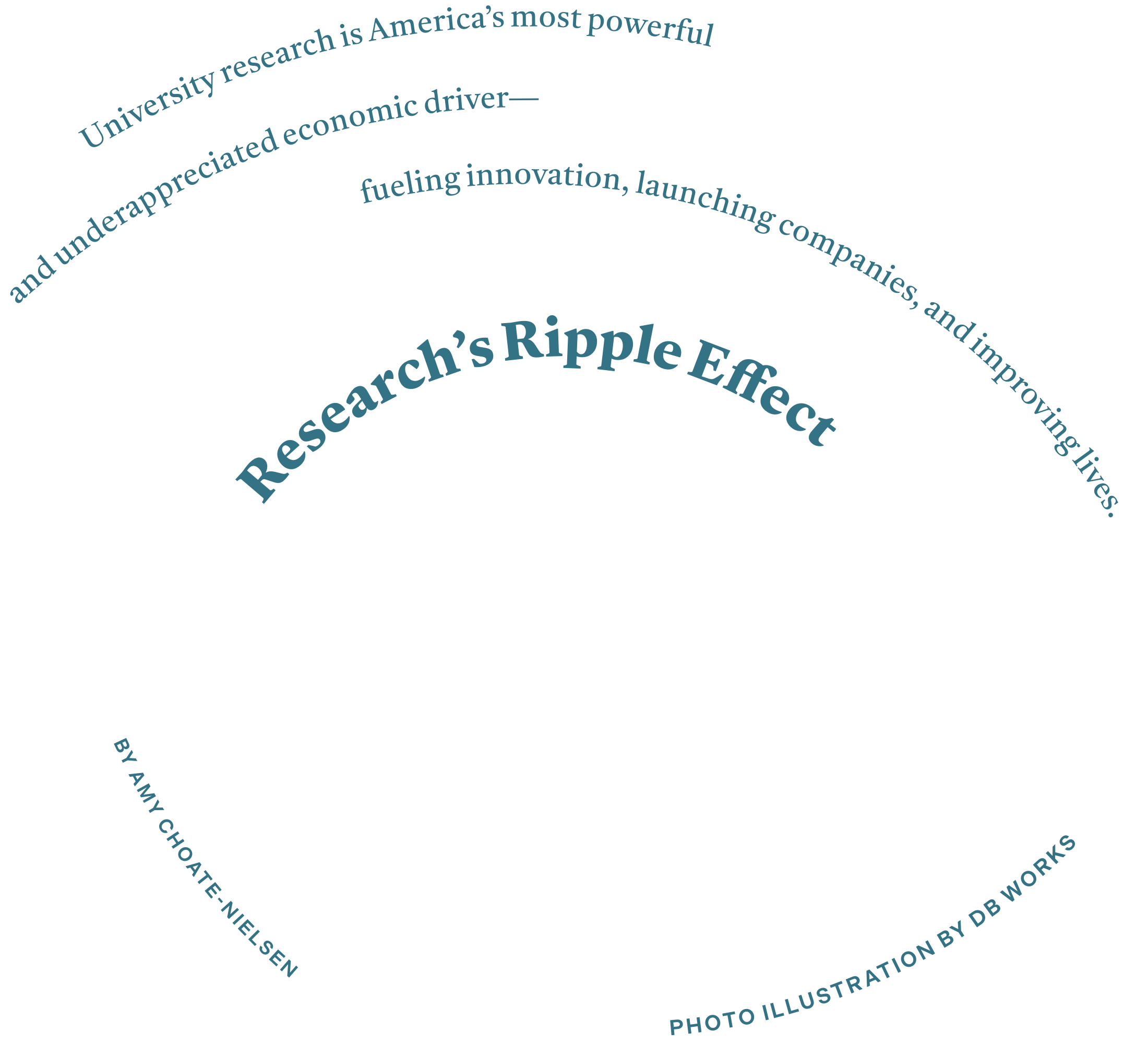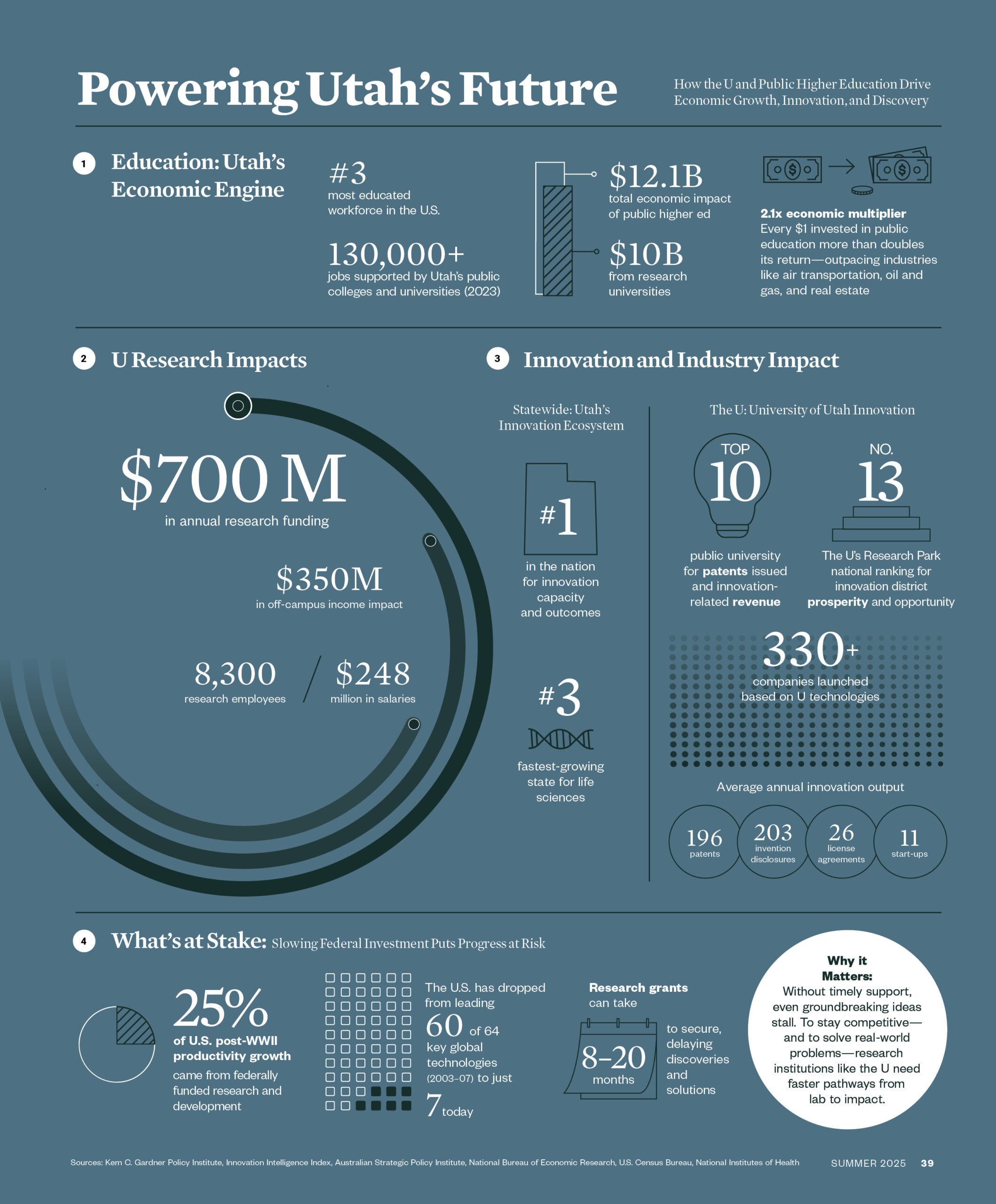In this place, where machines hum and hiss and expel so much heat the air conditioning can’t keep up, extraordinary things take shape: A swatch of flexible chainmail, a honeycomb-latticed hollow football, a prosthetic implant for a broken bone—all made from powdered metal—may catch your eye. But the Titanium Additive Manufacturing Research Center is much more than a 3D printer’s dream.
Here, the next breakthrough in manufacturing is baking. Fang’s industry partner, IperionX, calls it titanium’s “Bessemer moment,” echoing Henry Bessemer’s 1854 invention that transformed steel into the ubiquitous backbone of railroads, skyscrapers, and machinery. The implication is staggering: Fang’s research at the U could be the key to creating a sustainable, affordable titanium supply chain in the United States. And it’s only one example of many groundbreaking explorations unfolding at universities across the country.
In Utah, higher education drives the state’s economy through innovation, job and business creation, and workforce training. While medical advancements, start-up companies, and even the World Wide Web have flourished through the U, vital research now faces threats that could slow its progress. As the race to develop crucial technologies intensifies, there is precious little time to lose.
That may be one reason why, during spring break, Fang’s students are in the lab running experiments. This work takes years. “There must be more than 20 different process methods purported to be low-cost, but they never succeeded,” Fang says. “This time, we’re going to be the ones who do.”
Boosting Innovation
As the ninth most common element on earth, titanium is not considered rare—but it is expensive to process. Prohibitive costs currently limit use of the material beyond its critical role in the aerospace, defense, and chemical industries; however, Fang’s research could transform titanium into a household metal. His method cuts the amount of energy and production time needed to process the element by more than 75 percent, making it a revolutionary innovation that could impact all of Utah and beyond.
The Beehive State ranks first in the U.S. for innovation capacity and outcomes, per the Innovation Intelligence Index. Home to 16 public colleges and universities, including two research-intensive universities, Utah’s education system catalyzes the state’s top innovation ecosystems in aeronautics, energy production, finance, technology, and life sciences. With this valuable system, Utah is positioned as a rising start-up hub, with more than 330 companies launched from the U alone.
“Higher education is Utah’s most powerful economic engine. We connect research innovation with market needs. And we don’t just create companies—we build healthier communities and solve problems that matter to people right here in our state,” U President Taylor Randall HBA’90 says. “That’s the real return on investment.”
Under Randall’s vision, the U aims to produce paradigm-shifting research with unsurpassed societal impact. That mission requires better pipelines to move ideas into production. In 2024, the U launched the Applied Medical Engineering Lab and its first Remote and Austere Conditions Grand Challenge, offering up to $1 million to faculty developing solutions for rural communities and military personnel and others in isolated environments. The U also partnered with EPIC Ventures to provide faculty entrepreneurs with funding, business expertise, and advisory networks to help turn promising ideas into thriving start-ups.
“As a major research university, our challenge is making scientific discovery faster and increasing innovation’s real-world impact,” says Erin Rothwell PhD’04, U vice president for research. “The stakes are high—if we don’t accelerate this process now, our children won’t enjoy the same quality of life we have in 20 years.”
To speed up life sciences discoveries, the U will complete construction on a one-of-a-kind building, the James LeVoy Sorenson Center for Medical Innovation (SCMI), thanks, in large part, to a generous lead gift of $22 million from the Sorenson Legacy Foundation. SCMI will house innovation labs, symposium space, manufacturing sterilization facilities, fresh tissue operation tables, and start-up incubators. “A building like this just doesn’t exist,” Mark Paul BA’87, executive director of the Center for Medical Innovation, notes. “This allows us to shine in a way that no other university can.”
As the former global division president of Stryker Neurovascular, a medical technology leader based in Salt Lake City, Paul understands how the life sciences create jobs across the economic spectrum—from physicians to manufacturing workers. Utah ranks as the third fastest-growing state in the life sciences industry, with some 1,600 companies spanning medical devices, pharmaceuticals, diagnostics, and imaging.
Paul now oversees the Bench to Bedside program—launched 15 years ago and now with 325+ inventions to its credit—connecting student inventors with manufacturing opportunities. From a cancer-illuminating portable wand to an expandable tool that reinforces broken bones, the products students design could transform medical treatment in Utah and beyond.
“I think this next generation will be the greatest inventors in the history of mankind,” Paul says. “They were born into innovation.”
Building the Economy
Students come to Fang’s lab from various paths, including manufacturing, and chemical and metallurgical engineering. Together, these undergraduate and graduate students are forging a manufacturing workforce as strong as the titanium structures they’re fusing with lasers and heat.
Across the country, a skilled workforce is essential to attracting employers. Utah’s position as home to the nation’s third most well-trained and educated workforce owes much to the Utah System of Higher Education (USHE) schools, which enrolled more than 240,000 students in the 2024 school year alone.
“Right now, technological advancements are driving a knowledge economy that demands the most well-educated citizenry and well-trained labor force in human history,” Natalie Gochnour BS’84 MS’88, director of the Kem C. Gardner Policy Institute, recently told reporters at a press conference about the value of higher education. “Training is what universities do to help people get a job. Education includes intellectual and personal development that’s deemed essential to civil society. At Utah’s institutions of higher learning, we do both.”
In 2024, about 72 percent of students graduating from USHE schools earned degrees that relate to high-wage and high-demand jobs. These are the much-needed future mechanical engineers, nurse practitioners, and software developers of the state. Each engineering or computer science job in Utah supports up to two additional jobs, according to a 2022 report from the Gardner Institute.
Beyond workforce development, USHE schools themselves supported approximately 132,000 jobs in 2024, about 5.5 percent of jobs statewide. Higher education also directly contributed $12 billion to Utah’s economy—with the U and Utah State University, the state’s research institutions, accounting for $10 billion of that impact.
Research universities attract substantial outside funding. These grants percolate into the economy through facilities and administrative costs, covering everything from utilities to building maintenance. Annual research funding brings $134 million to USU and nearly $700 million to the U. For every dollar invested in education, the economic return more than doubles—outpacing industries like oil and gas extraction or air transportation, according to a recent report from the Gardner Institute.
“The economic impact of higher education is multi-pronged,” Rothwell says. “You can’t just pinpoint it to start-ups or bringing in federal grants. It’s a complete ecosystem that changes the nature of the economy and the future of Utah.”
Supporting Research
For someone who holds the world’s only patent on how to create titanium primary metal with less energy, emissions, and cost, Fang is decidedly humble. He left his industry job of 11 years to come to the U where he would be paid less but could research more. “Working for a company, you are assigned to one product. That’s your thing,” Fang says. “I like the university environment, where we have more freedom to work on different areas.”
Fang’s research has spanned hard materials, hydrogen storage, refractory, reactive, and rare earth metals, and now, additive manufacturing—a field that didn’t exist 20 years ago. The ability to adapt and respond to technological advances is crucial to navigating the future, especially now, as university research in the U.S. faces unstable federal funding and is losing ground in critical technology leadership.
From 2003 to 2007, the U.S. dominated 60 of 64 foundational technologies that shape the global economy, national security, defense, energy, health, and more, according to the Australian Strategic Policy Institute. Today, the U.S. leads in just seven areas—vaccines, quantum computing, genetic engineering, and nuclear medicine among them. The race to reclaim technological leadership is on, and leaders in Utah are feeling the heat.
“We all know that we are in an arms race to control artificial intelligence,” Utah Senate President Stuart Adams BA’78 said in his opening address of the Utah legislative session in January. “The country that controls AI will, in turn, control the world.”
Adams urged Utahns to lead the way, and the U is already answering that call with Randall’s One-U Responsible AI Initiative, which aims to harness AI for societal good. Researchers across campus are tackling similarly urgent issues that can save lives and improve the world. Scientists are studying food scarcity and ways to leverage communications research and psychology to develop innovative mental health interventions. Meanwhile, Utah’s geology—with 40 of the 50 critical minerals needed for emerging technologies—makes the U a strategic hub for geoscience research with national security and defense applications.
“What many people don’t realize is that university research is quietly powering economic growth in ways that go far beyond campus,” Randall explains. “What might look like abstract work in a laboratory directly translates to jobs, new companies, and innovations that solve real-world problems. Investment in higher education research is actually one of the most powerful economic engines we have—and the impact ripples through every part of society.” u
Amy Choate-Nielsen is associate director of strategic communications at the U.
10 U-Born Business Giants
① Adobe Inc.
Co-founded in 1982 by John Warnock BS’61 MS’64 PhD’69, the $21 billion global software giant employs more than 26,000 people worldwide. Warnock’s innovations—including PostScript, Illustrator, and the PDF—revolutionized how the world creates and shares digital content.
② Atari
Nolan Bushnell BS’69 revolutionized home entertainment when he co-founded Atari in 1972, which created the first commercially successful arcade game, Pong. The company’s golden era defined the modern video game industry.
③ Blackrock Neurotech
A global leader in brain-computer interface technology, this enterprise was co-founded by U professor of electrical and computer engineering Florian Solzbacher. Its groundbreaking Utah Array—first developed at the U—enables people with paralysis to control robotic arms, computer cursors, and more using only their thoughts.
④ BioFire Diagnostics
This disruptive company traces its origins to the U, where Kirk Ririe BS’05, Randy Rasmussen PhD’98, and Carl Wittwer (Residency’88) collaborated on early inventions. BioFire has transformed infectious disease testing with the FilmArray system—now a hospital mainstay for rapid detection of respiratory, gastrointestinal, and bloodstream infections.
⑤ Evans & Sutherland
Founded in 1968 by computing visionaries David Evans BA’49 PhD’53 and Ivan Sutherland, a U professor of computer science, Evans & Sutherland cracked open the digital frontier with innovations in 3D graphics that launched virtual reality into existence. Their revolutionary work not only shaped how we visualize technology—it helped ignite Utah’s explosive tech boom.
⑥ Pixar
The groundbreaking animation studio that Ed Catmull BS’69 PhD’74 helped launch in 1986 transformed filmmaking with revolutionary computer animation—built on technology Catmull developed at the U.
⑦ Recursion
From U spinout to $2 billion biotech powerhouse, this venture co-founded by Chris Gibson PhD’13 now operates as a clinical-stage techbio company running one of the world’s most powerful supercomputers to decode biology and industrialize drug discovery at massive scale.
⑧ Silicon Graphics and Netscape
Jim Clark PhD’74 shaped the digital age with two trailblazing companies: Silicon Graphics revolutionized 3D computer graphics for film and design, while Netscape launched the world’s first widely used web browser.
⑨ Utah FORGE
Led by U scientists, this $218 million Department of Energy-funded project is developing enhanced geothermal systems that could make clean electricity available almost anywhere by harnessing heat from deep within the Earth.
⑩ WordPerfect
Co-founded in 1979 by Alan Ashton HBA’66 PhD’70, it became the world’s leading word processing software in the 1980s and helped turn Utah Valley into a tech hub long before it was dubbed Silicon Slopes.
OrthoBolt
Mitchell Kirkham BIO’20 and Brandon Wilde had a hunch they could revolutionize bone repair. “Traditional pedicle screws aren’t much more innovative than something you would grab from a hardware store,” Wilde explains. The duo earned the 2024 Bench to Bedside Grand Prize Runner-up Award with their solution—OrthoBolt, an expandable orthopedic screw for optimal anchoring in osteoporotic bone. They’re now finalizing their first prototype for testing.
C-Blu
Libby Brooks and her team won the 2024 Bench to Bedside competition with a product that could improve cervical cancer screenings, especially in low-resource areas. The C-Blu device causes cervical cancer lesions to fluoresce, making them easier to see and diagnose. With $20,000 in milestone funding from the competition, the team is now refining its third prototype and preparing for clinical testing. “We are motivated by the idea of making something that could actually change people’s lives,” Brooks says.








Comments
Comments are moderated, so there may be a slight delay. Those that are off-topic or deemed inappropriate may not be posted. Your email address will not be published. Required fields are marked with an asterisk (*).